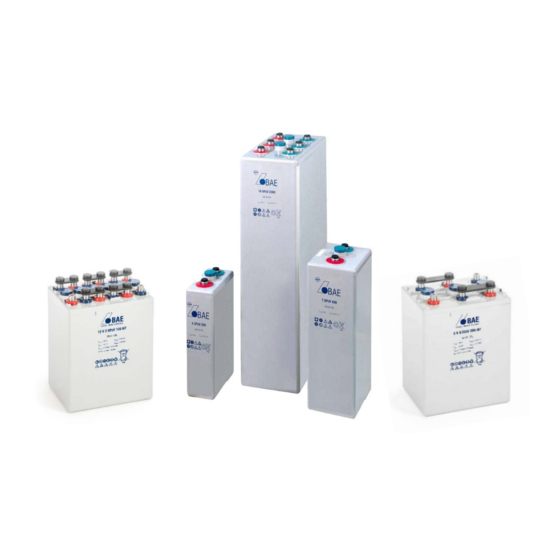Subscribe to Our Youtube Channel
Summary of Contents for BAE OPzV Series
- Page 1 STATIONARY BAE BATTERIES: Valve Regulated Lead Acid (VRLA) Installation and Operating Instructions OPzV & OGiV Series Batteries Important Documents - Do Not Discard...
-
Page 2: Introduction
Stationary Valve Regulated Lead Acid (VRLA) Batteries, Installation and Operating Instructions This publication defines the essential requirements for the proper storage, handling, assembly, commissioning, operation, and maintenance of the BAE OPzV and OGiV stationary valve regulated lead-acid batteries. 1.0 SAFETY PRECAUTIONS & WARNINGS •... -
Page 3: Electrolyte Hazards
Stationary VRLA Batteries, Installation and Operation Instructions 1.1 ELECTROLYTE HAZARDS The electrolyte is dilute sulfuric acid, which is harmful to skin, and eyes. It is electrically conductive and corrodes unprotected metal surfaces. PRECAUTIONS a) When handling electrolyte wear full eye protection, rubber or plastic gloves, apron and boots. -
Page 4: Table Of Contents
Stationary VRLA Batteries, Installation and Operation Instructions TABLE OF CONTENTS: INTRODUCTION ………………………………………………………………………………........1 1.0 SAFETY PRECAUTIONS & WARNINGS ………………………..………………………………..……...……. 1 1.1 ELECTROLYTE HAZARDS ……………………………………………………...……………………..…. 2 1.2 ELECTRICAL HAZARDS ……………………………………………………………………..…………………. 1.3 EXPLOSIVE GASES ………………………………………………………………………..……………………. 2 TABLE OF CONTENTS ………………………………………………………………………………………...……... 3 2.0 RECEIVING OF STATIONARY BATTERIES ………………………………………………....…... 4 2.1 VISIBLE EXTERNAL DAMAGE ..………………………………………………………………..……...….. -
Page 5: Receiving Of Stationary Batteries
If any of the above are observed, make a note of it on the bill of lading before signing. NOTE: Shipping damage must be handled with the carrier -- not BAE Batteries USA 2.2 CONCEALED DAMAGE It is recommended that the cells be unpacked and checked for concealed damage as soon as possible. -
Page 6: Storage And Maintenance: Vrla Batteries
Installation and Operation Instructions 3.1 STORAGE AND MAINTENANCE: VRLA BATTERIES BAE VRLA Gel batteries may be stored without further charging only for a limited period because of self-discharging and related chemical processes. After a maximum storage period of 24 weeks at 25°C (77°F) or less (or 12 weeks at ambient temperatures above 25°C (77°F)) the batteries must be charged by connecting... -
Page 7: Accessories
NOTE: A mechanical battery lift may also be used to move the cells. If your visual inspection, after unpacking, indicates damaged posts, cell covers or jars, file a claim against the carrier and contact BAE USA or your local representative. 4.1 ACCESSORIES When unpacking the cells, place the accessories along with the installation and operating instructions in a safe location to avoid misplacement or loss. -
Page 8: Racks (New Rack)
If the new rack is not designed for the new batteries being installed this could affect your seismic rating and battery warranty. Please contact BAE USA or your local representative with questions. 6.0 BATTERY CELL/JAR INSTALLATION SAFTEY REMINDERS –... -
Page 9: Installation On Racks - Horizontal Mount
Failure to observe this step could result to damage to the cells. See “BAE OPzV Horizontal Reference Installation Instructions” for seismic stacked module detailed install instructions. This is a separate BAE Batteries USA instruction document. Important: For horizontal racks with battery rails instead of module shelves, please be sure the lip between the jar and cover is not sitting on the front rail, it should be overhanging as shown below. -
Page 10: Terminal Plates
All bolted connections should be made using a calibrated torque wrench to insure proper tightness of the connection without causing any damage to the battery posts. The torque settings for the BAE M10 Allen bolt is: • 22 Newton-meters or 195 (194.7 actual) inch-pounds. -
Page 11: Commissioning Batteries
If OCV is < 2.10V but ≥ 2.08V, then a higher boost charge as defined in Section 7.0.2 will be required o If OCV is < 2.08V contact BAE USA or your local representative. Once the pre-commissioning charge measurements are completed, the commissioning charge can begin. -
Page 12: Commissioning With Higher Charging Voltages - 2.33 To 2.40 Vpc
8.3 CHARGING CURRENTS The charging current on the BAE cells does not need to be limited until the battery voltage has reached 2.40 VPC x number of cells - thereafter the charging current has to be limited to 1.5A per 100 Ah of battery capacity. -
Page 13: Temperature-Related Charging Voltage
8.5 OPERATING TEMPERATURE All nominal data for BAE stationary batteries is stated based on an operating temperature of 25°C (77°F), the recommended operating temperature range for the BAE cells is 10°C (50°F) to 30°C (86°F). To maximize life and performance the ideal operating temperature range is 20°C (68°F) to 25°C (77°F). -
Page 14: Battery Maintenance
In certain circumstances, specific cleaners may be used. However, you must consult with BAE USA or your local representative prior to use. If approved, after application of the cleaner the cell should be rinsed with water and thoroughly dried with a clean damp cloth. -
Page 15: Total System Voltage And Current
Single Cell Voltage Tolerance is +0.2 or -0.1V as compared to the nominal voltage of 2.25; this gives us a range of 2.15 to 2.45 volts If the individual cell voltages are not within the allowable tolerances contact BAE USA or your local representative for recommendations. - Page 16 Installation and Operation Instructions • The timing of the corrective action for increased connection resistance should be determined by an analysis of the effects of the increased resistance. Consult BAE USA or your local representative if there are questions. • Whenever all battery connections are cleaned and reassembled, a new baseline should be established.
- Page 17 IEEE 1188 or contact BAE USA or your local representative. 11.0.8 If the target capacity is not achieved, we request that you contact BAE USA or your local representative. It is generally recommended that if the measured capacity of the battery is less than 80% the battery should be considered for replacement.




Need help?
Do you have a question about the OPzV Series and is the answer not in the manual?
Questions and answers